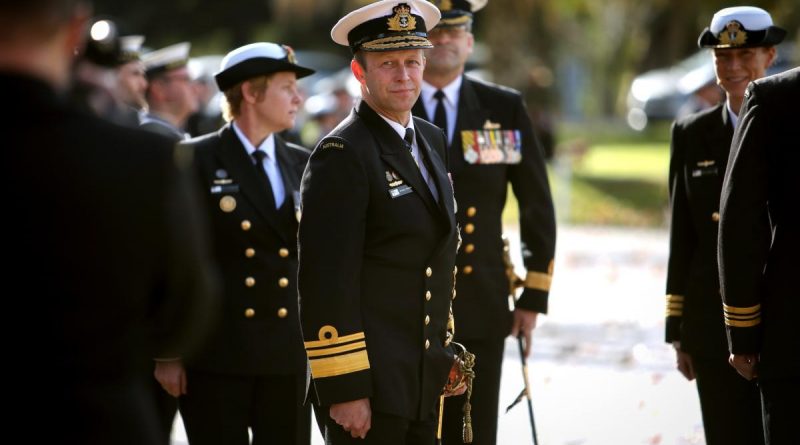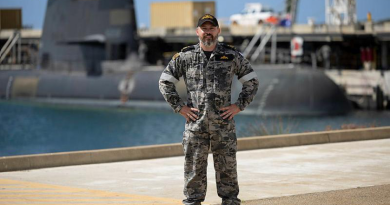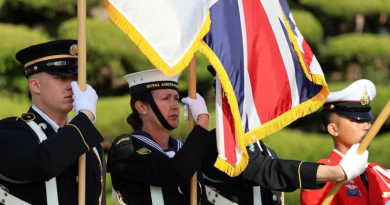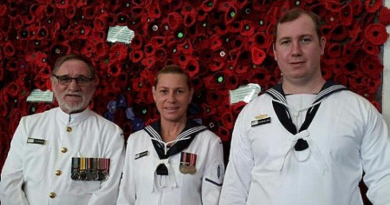Farewell statement from Chief of Navy

CAPTION: Chief of Navy Vice Admiral Michael Noonan inspects the guard during the commissioning ceremony for HMAS Encounter at Torrens Parade Ground, Adelaide, South Australia. Photo by Able Seaman Susan Mossop.
Statement from the Chief of Navy
Vice Admiral Michael Noonan
It has been my great honour and privilege to serve as Chief of Navy for the past four years.
I sincerely thank the women and men of the Royal Australian Navy for their outstanding work and dedication during my term. They reflect the very best of Australian society; Australians who are ready to defend Australia and its national interests in the maritime domain.
I am incredibly proud of the unprecedented support Navy people provided to our country during the COVID-19 pandemic, while also maintaining Navy’s regular operations; protecting Australia’s maritime approaches and vital trade routes, conducting essential border protection activities and maintaining a consistent presence in the south-west Pacific and wider Indo-Pacific region.
It has been a difficult two and a half years for our nation, and indeed the world, but the way Navy people have responded to these challenges is a testament to their resilience, strength and adaptability. Likewise, our people have been ready and willing to deploy at a moment’s notice to provide humanitarian assistance and disaster relief for Australians during the bushfires of 2019-20, when floods struck eastern Australian earlier this year, and when Fiji and Tonga called for assistance following natural disasters.
From my first day as Chief of Navy in July 2018, I have highlighted the need to be a thinking Navy, a fighting Navy and an Australian Navy. We have achieved much in four years to this end, and I am particularly proud of the many things that we have achieved to improve the culture of our Navy and the workplace environment, conditions and safety for all of our people.
We have grown into a larger, more diverse workforce of more than 15,000 people, and we have enabled the Defence total workforce model to deliver a fully integrated workforce, with greater flexibility in the options to render, or in fact return, to Navy service. I am also proud to have seen the award of our Navy’s only Victoria Cross for Australia to Ordinary Seaman Edward ‘Teddy’ Sheean VC, and the identification of the unknown sailor from the sinking of HMAS Sydney II as Able Seaman Thomas Welsby Clark.
We have built and deepened our partnerships with Australia’s Defence Industry, and with our international friends, allies and partner navies. We have launched a robotics, autonomous systems and artificial intelligence strategy to increasingly leverage emerging technology and human-machine teaming to transform, and improve, our ability to fight and win at sea.
Navy’s fleet has continued to undergo its biggest evolution since World War 2 in order to respond to the changing strategic environment. Our final two Hobart-class destroyers HMA Ships Brisbane and Sydney, were commissioned into Navy’s fleet – these modern, advanced warships significantly enhance the lethality of our fleet and enable interchangeability with the US Navy.
Two new auxiliary oiler replenishment ships, HMA Ships Stalwart and Supply, joined the fleet in 2021 and have significantly enhanced Navy’s capacity to conduct sustained operations within the joint force.
Defence has also launched NUSHIP Arafura, the first of 12 Arafura-class offshore patrol vessels, and taken ownership of the first of six evolved Cape-class patrol boats.
It has been a time of considerable change, and Defence has continued to assess future capability in response to changes in the strategic and threat environment.
The most consequential of these decisions has been the Australian Government’s announcement in September 2021, that at least eight nuclear powered submarines would be acquired for the Royal Australian Navy through a trilateral security partnership between Australia, the United Kingdom and the United States, known as AUKUS.
The accelerating changes to regional security, outlined in the 2020 Defence Strategic Update, mean that conventional submarines will not meet Australia’s operational needs in the decades ahead. With their superior stealth, speed, endurance and manoeuvrability, nuclear-powered submarines are the best option to meet Australia’s strategic and defence capability requirements over the coming decades.
Our Collins-class submarines will continue to be Australia’s most potent and agile deterrent and offensive capability until they are replaced by the nuclear-powered submarines. The Collins-class remains one of the most capable conventionally-powered submarines in the world. All six of our Collins-class submarines will undergo significant upgrades as part of the life-of-type extension program.
At this important and pivotal time, I am confident I leave Navy in great hands. Rear Admiral Hammond is an exceptional leader, and a submariner with experience in Australian and Dutch conventional submarines, and French, British and US nuclear attack submarines.
I congratulate him on being appointed as our next Chief of Navy.
My thanks and very best wishes to you all.
Vice Admiral Michael Noonan
.
.

.
.





